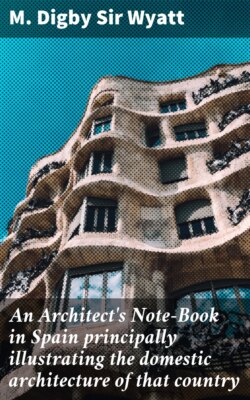Читать книгу An Architect's Note-Book in Spain principally illustrating the domestic architecture of that country - Sir M. Digby Wyatt - Страница 16
На сайте Литреса книга снята с продажи.
VALLADOLID. SMALL PATIO, COLEGIO DE SAN GREGORIO.
ОглавлениеTHE stucco upper-storey from which the last sketch (Plate V) was taken, rests upon a lower open storey, forming the usual recessed Arcade or Colonade of even very humble Patios. In this case, the columns, on two sides, (the upper parts of one of which are shown) including the coat-of-arms, are in stone; while the brackets easing the compression of the fibres, and shortening the bearing of the beams, the beams themselves, and the row of brackets above, being really only the moulded ends of the joists of the upper floor, are all in wood. They thus illustrate the combination of materials in construction so much affected by the Moors. At the same time the architectural details shown both in this sketch, and in the one which precedes it, exhibit certain ornamental features derived from Arabian models. That there should be no question in this structure, however, as to the ascendency of the Christian over the Moor, the proud founder has affixed his arms, in which the Church's sacred emblems of the fleur-de-lys and cross forcibly express the favourite tenets of the Spaniard.
Few cities of Spain more rejoiced in heraldic devices than did Valladolid, the especial seat of the Castilian nobility, at least until its removal to Madrid. Amongst all the beautiful fac-similes of finely-mantled and well-displayed escutcheons which adorn the works of early printers, given to us by Sir Stirling Maxwell, few excel those which issued from the presses of the Valladolid printers. The Germans who followed in the train, or, at any rate under the auspices, of Charles V., no doubt set the fashion at the commencement of the century at Seville, which was taken up by Spaniards towards the middle of the same century at Valladolid. Francesco Fernandez de Cordova appears to have been the great master of the craft there, and many and splendid are the heraldic frontispieces of his books from 1548 onwards. His style, at any rate, was maintained in his family till near the end of the century, as the title page of the celebrated "Quilatador de la Plata oro y piedras," by Joan Arphe, 1572,[6] displays the arms of the Cardinal Bishop of Siguenza, drawn by, and bearing the initials of, no less an artist than Arphe y Villafañe himself. The imprint of the volume bears no longer the name of Francisco, but the names of Alonzo y Diego Fernandez de Cordova.
The finest specimen of Francisco's work, given by Sir Stirling Maxwell, is the grand heading to a proclamation issued by Charles V., in 1549. It exhibits not only the Royal and Imperial escutcheon, Double-headed Eagle, and Columns, with the proud motto "plus ultra," but a quantity of pure Renaissance ornament from which all trace of Gothic has disappeared.
